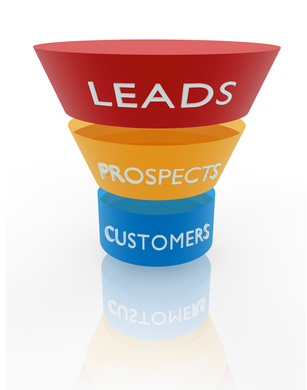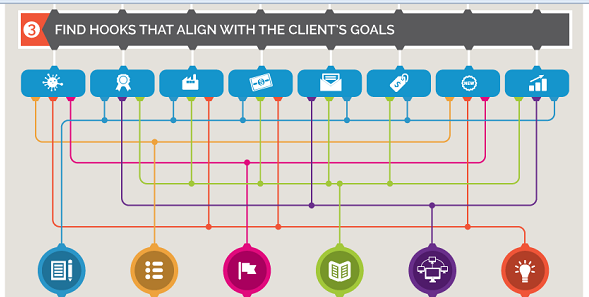Attribution -- Tracking Points of Contact Before a Conversion
By Jaco Grobbelaar on Thu, Oct 24, 2013 @ 07:55 AM

 I have been wondering exactly how to count the many points of touch or contact a potential client has before becoming a client since Ann Mullen wrote about the how a client becomes a client and I wrote about the activity of the leads. What sort of analytics are there to get some idea? I found one writer who said, “Sales specialists believe that it takes around 7 points of touch for a company to convert a lead into a customer.”
I have been wondering exactly how to count the many points of touch or contact a potential client has before becoming a client since Ann Mullen wrote about the how a client becomes a client and I wrote about the activity of the leads. What sort of analytics are there to get some idea? I found one writer who said, “Sales specialists believe that it takes around 7 points of touch for a company to convert a lead into a customer.”
___________________________________________________
Related article: Local Inbound Marketing: How Your Client Becomes Your Client
___________________________________________________
So I went looking for those sales specialists and couldn’t find them. However, I did find a person, Faith Seekings, in an article How Many Points of Contact Does It Take to Make a Sale, who said,
They used to say it takes seven points of contact to make a sale. Today that number is much higher due to the advent of the web and the amount of sales messages we receive daily through newsletters, Google ads, LinkedIn messages, blog posts, etc. – especially in the B2B space. Whatever the number, the key is still the same: the more and more kinds of points of contact the better in order to reach your audience, when they want to buy.
So we can estimate that it takes some number between 7 to a whole lot more for a person to engage with a company before becoming converted.
Attribution--A Magic Word
To begin with we need to look at a word “attribution” as used in marketing analysis. Most of the best information I found came from an article by Meghan Kearney Anderson called Understanding How Your Marketing Analytics Giver Credit for Conversions. This article is from Hubspot, but you can use the information in whatever analytics software, platform or program that you want.
Meghan explains what attributions means as
'Attribution' is a way of understanding which marketing channels or campaigns contributed to a conversion on your website. In HubSpot software, for example, you'll notice that our Marketing Analytics tools report on the number of leads and customers generated through various marketing efforts -- that information is what you'd call an attribution. But because a lead's or customer's lifecycle with your company is made up of a number of different interactions, there are multiple ways to report on attribution. Understanding how attribution works will help you understand which of your marketing efforts are actually generating results.
What an attribution is seems to have something to do with points of contact a person has with your company, which we all agree are numerous. So how do we go about learning where all those places are that the potential client has had contact? There are actually 3 methods and each has its positives and its drawbacks. They are called Last Touch Attribution, First Touch Attribution and Assists Attribution.
Last Touch—End of the Line
 Last touch attribution is the easiest to report. Someone goes on to Facebook, sees a reference to an article you wrote, clicks onto the report and is now on your site. Then the person either buys something or requests a free report. The last touch was Facebook. Most analytics software use last touch attribution for reporting. Google Analytics does, too, although I did find an article about how you can learn more from Google called Lead Attribution: “Company Website” Isn’t Enough. We are not going to get into the how-tos in this article. For now we are still in exploration mode. So let’s go back to Meghan’ general information.
Last touch attribution is the easiest to report. Someone goes on to Facebook, sees a reference to an article you wrote, clicks onto the report and is now on your site. Then the person either buys something or requests a free report. The last touch was Facebook. Most analytics software use last touch attribution for reporting. Google Analytics does, too, although I did find an article about how you can learn more from Google called Lead Attribution: “Company Website” Isn’t Enough. We are not going to get into the how-tos in this article. For now we are still in exploration mode. So let’s go back to Meghan’ general information.
On the positive side last touch analytics can tell you what is working right before someone converts. If you get a lot of people visiting your site after you do an email campaign, you know that that is a successful method for you. But you still don’t know how many times those people came in contact with your brand before that.
First Touch—But Do We Have a Sale Yet?
Next we come to first touch attributions. These answer the question about how did the person first come into contact with your brand. Hubspot has some clever ways they break this down in their Sources report, that show which channels brought in the leads the first time. That’s nice for finding out the channels that are the best bets; but again, this only shows the first time a person actually gets on a site, not the number of times he or she saw your brand and went no further. So, for example, if the first time the person went on to the site was from a Google search, then he or she comes and goes many times before actually buying a product or using your service, whatever was going on in between is not apparent.
Assists Attribution—Middle of the Road
 Meghan begins her explanation of assists attributions by saying,
Meghan begins her explanation of assists attributions by saying,
If first touch attribution shows you how a lead originally came across your website, and last touch attribution shows you the final interaction that triggered a conversion, I bet you can guess what assists attribution reveals. Marketers use assists reporting to identify the pages that were viewed throughout the lifecycle of people who ended up converting.
And here is what I have been looking for, hiding in plain sight. While we know that the first or last page a person looks at before conversion doesn’t tell us everything we need to know, they do tell us important information about our processes. The assists attribution gives the best insight for what is in between or the middle of our sales funnel. What are some of the other ways a person visited the brand before making the decision? Which platforms have the best views in general? What are the platforms used by the largest percentage of people who later convert? Those are two different questions, by the way.
___________________________________________________
Related article: Inbound Marketing’s Dance: Activity of the Leads
___________________________________________________
There are so many different ways of looking attribution that sometimes the analyses can become confusing. Mehgan says,
The best approach to marketing analytics is to start with a question. Determine what it is you want to know, and then find the attribution method and analytics report that will get you the closest to the answer.
Only by figuring out what you want to know, can you look for ways to get that information. In my case I am curious about the entire spectrum so I make use of all three. What do you want to know about your converted client?
 Jaco Grobbelaar is the owner of BroadVision Marketing. BroadVision Marketing works with business owners to put in place inbound and outbound marketing strategies that consistently secure new clients. The BroadVision Marketing Training Center is located in Petaluma, CA and primarily serves companies in the San Francisco Bay area.
Jaco Grobbelaar is the owner of BroadVision Marketing. BroadVision Marketing works with business owners to put in place inbound and outbound marketing strategies that consistently secure new clients. The BroadVision Marketing Training Center is located in Petaluma, CA and primarily serves companies in the San Francisco Bay area.
Jaco can be reached at jaco@broadvisionmarketing.com or 707.766.9778 or connect with Jaco on Facebook - www.facebook.com/broadvisionmarketing - and LinkedIn - www.linkedin.com/in/JacoGrobbelaar. He can also be found at Jaco+.
You May Also Like
These Related Stories

New Adventure in Local Inbound Marketing: Cornerstone Content

What is the Point of Your Social Media Plan? Is It Successful?

.png?width=302&height=75&name=BVM%20Logo%20-%20transparent%20(1).png)

No Comments Yet
Let us know what you think